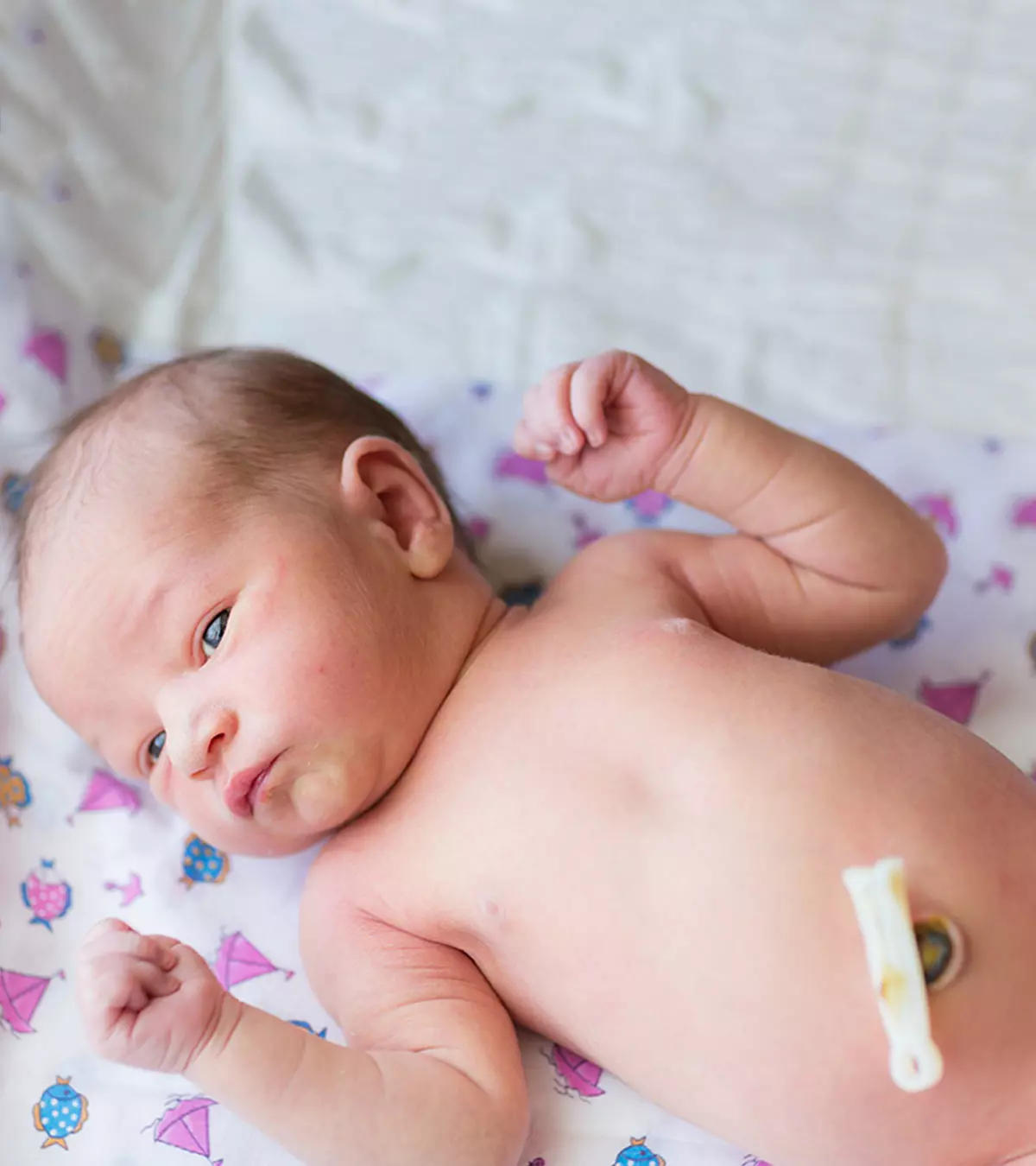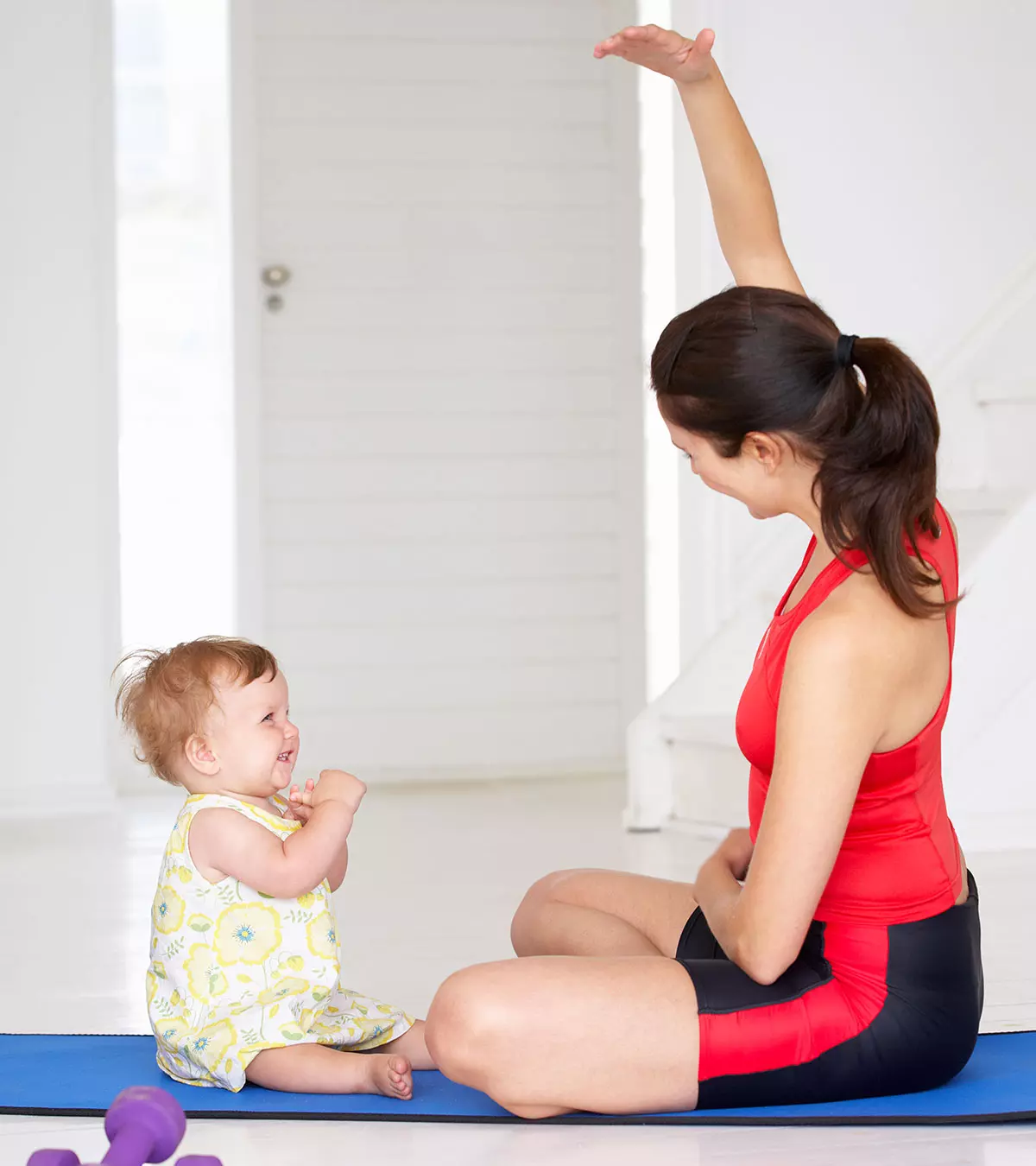
Image: Shutterstock

Yoga helps improve physical and mental well-being, and practicing yoga is an excellent and healthy way to bond with your baby. Whether you have been practicing yoga or are a beginner, yoga poses for mom and baby are simple and easy to follow. The ancient practice also helps new moms stay fit and keeps stress at bay (1).
Yoga also serves as an exciting and effective exercise regimen after nine long months of pregnancy and gets you on a structured postnatal wellness path. In this post, we share some effective yoga poses for moms and babies. Keep scrolling and try some.
Key Pointers
- Yoga can help new moms bond with their babies and stay fit and stress-free.
- If you’ve had a cesarean delivery, consult a doctor before practicing yoga.
- Practice yoga on an empty stomach, use a flat surface, maintain eye contact with the baby, and stop if you feel pain.
- Simple and effective poses like the corpse, cobra, tree, and child pose can be done with your baby.
Care To Take While Doing Yoga
Before beginning with the asanas, we’ll tell you about the care you need to take while performing yoga.
- Make sure your bowels are clear.
- Do yoga on a soft surface.
- If you are uncomfortable with any pose, then skip it.
- In the case of knee, back or wrist pain, stop immediately.
- Keep your face relaxed, smile at your baby, and maintain eye contact.
- Do not overdo any asana.
- You can start off gently, and gradually increase the pace as your body becomes flexible.
- Consult your doctor before you start practicing yoga, especially if you have had a cesarean delivery.
 Be watchful
Be watchfulNow, let’s start with the yoga poses.
Yoga Poses For Mom And Baby
Practicing yoga with your baby can be a wonderful way to bond and promote their physical wellness. Here are some poses that encourage interaction and playfulness to make the experience enjoyable for both of you.
1. Child pose (Balasana)

- Sit on your knees (Vajrasana)
- Place the baby in front of you
- Bend down while inhaling and pull your muscles in
- Stretch your arms in the front and touch the baby
- Stay in the pose for ten seconds
- Repeat five times. Gradually you can increase up to 30
Benefits:
- Contracts your muscles to pre-pregnancy state when done regularly
- Strengthens your lower back
- Stretches your thighs and hip muscles
- Reduces stress and tiredness
When to avoid:
- Diarrhea
- Knee and back injury
- Ankle problems
2. Cat and cow pose (Marjaryasana/ Bitilasana)

- Bend on your hands and knees. Place your baby on the mat facing you
- Your hips should be over your knees and shoulders over your wrists
- Inhale as you take the cat posture. Face your tailbone down, round your back, and look at your baby while exhaling
- Inhale while going into the cow posture. Lift your tailbone up and raise your head and chest up
- Smile or make faces at your baby as you look at them while moving your head up and down
- You may entertain the baby by making a “meow” sound in the cat pose and a “moo” sound in the cow pose.
Benefits:
- Stretches the back of your neck and torso
- Promotes better movement
- Strengthens the spine
- Relieves lower back pain
- Improves blood circulation
When to avoid:
- Injured or weak wrists and shoulders
- Weak knees]
3. Bridge pose (Setu Bandha Sarvangasana)
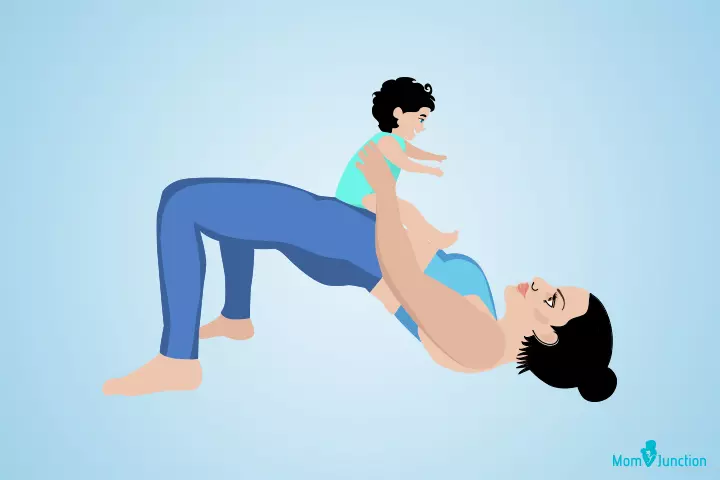
- Lie on your back with knees bent and foot firmly on the ground
- Let your baby face you resting on your thighs or hips. Your feet should be hip-distance apart
- Inhale and lift your hips off the floor
- Gradually, raise your back up to the shoulders as much as possible
- Use your hands to hold your baby
- Stay in the posture for 30 seconds
Benefits:
- Works on your buttocks and abs
- Strengthens your back and spine
- Reduces anxiety and calms your mind
- Relieves back pain
- Opens up your lungs
When to avoid:
- Neck pain or stiff neck
- A weak lower back
- Shoulder injuries
4. Boat pose (Navasana)

- Lie on the mat with your feet close and arms on either side of your body
- Place your baby on your lap. Lift your chest off the floor, while simultaneously lifting your feet off the floor
- Stretch your arms and lift your baby
- Stay in this pose for five to ten seconds
Benefits:
- Strengthens your abdomen and back
- Tones the leg and arm muscles
- Reduces belly fat
- Improves digestion
When to avoid:
- Diarrhea
- Breathing problems
- Heart issues
- Low blood pressure
5. Tiger pose (Vyaghrasana)
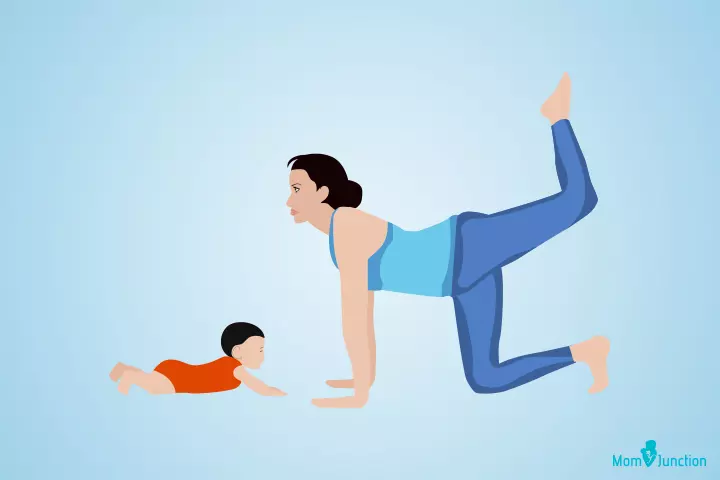
- Come down on all your fours. Let your baby face you
- Lift your right leg parallel to the ground
- Bend the raised right leg towards the front of your body
- Look up. You may stop here or do the full pose
- To enter the full pose, put the right hand back and try to hold your right leg below the ankle; raise the right foot up, arch the back and look up. Take 5-10 deep breaths. Then do the same on the left side.To entertain the baby, make a tiger’s “roar” sound
Benefits:
- Tones the lower body, arms, and shoulders
- Reduces back pain
- Improves digestion
When to avoid:
- A hernia
- A recent injury to the back or knees
- Back ailments
6. Triangle pose (Trikonasana)

- Stand with your legs four feet apart, and place the baby in front of you
- Raise your hands to the shoulder level, parallel to the floor
- Point your right foot outwards
- Touch your right foot with the palm of your right hand
- Inhale and lift your left hand up vertically; it should be above your head
- Look at the thumb of your left hand. Balance your weight on both your feet
- Breathe normally while maintaining the position and come back to normal position while exhaling
- Repeat it with the left leg
- Talk to your baby while doing the pose
- Repeat the pose five times
- You may teach a new word to your baby during this time as you repeat the word as many times as you do the pose
Benefits:
- Reduces belly fat
- Cuts down fat in the waist and hip area
- Strengthens lower body, arms, chest, spine
- Improves the body balance
- Strengthens the thighs, calves, and buttocks
- Relieves back pain, indigestion, and flatulence
- Relieves neck sprains and stiffness
- Strengthens the ankles and tones the lower part
When to avoid:
- A headache
- Hypertension
- Neck and back injuries
- Diarrhea
7. Squats (Malasana)

- Place your legs three feet apart; your toes should be pointing outwards
- Secure your baby in the carrier with their back facing you
- Exhale and bend your knees and lower your hips to squat but don’t touch the ground
- Position your knees straight over your ankles and fold your hands or embrace your baby
- Inhale and return to your position, or you may try the full pose
- Do the full pose by squatting with the feet together and knees spread apart. Bend forward, wrap your arms around the legs and clasp your fingers behind your back. Raise the head and look at your baby. Take 5 to 10 deep breaths.
Benefits:
- Strengthens your core and pelvic muscles
- Tones your lower body
- Shapes your buttocks
When to avoid:
- Knee injury
- Back and leg issues
8. Cobra pose (Bhujangasana)
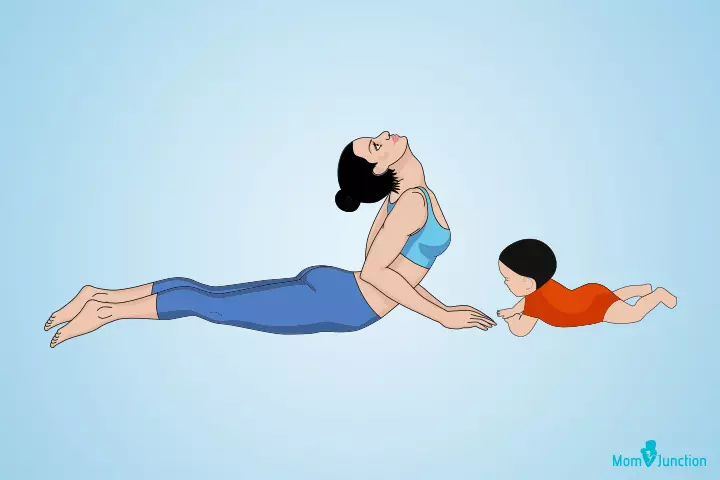
- Lie on your tummy, keep your legs together, and palms under your shoulders
- Rest your forehead on the floor
- Inhale and raise your head and rib cage up, and curve backward as much as possible
- Hold the position for a few seconds
- Exhale and come back to your normal position
- Repeat 5-10 times
- Place your baby in front of you and encourage them to imitate you
Benefits:
- Relieves lower back pain
- Tones abdomen muscles
- Strengthens the spine
- Improves blood and oxygen supply to your pelvis
When to avoid:
- Spinal injuries or surgeries
- A hernia
- Stomach ulcers
9. Knee planks and push-ups (Chaturanga dandasana)

- Lie on your tummy
- Keep your hands sideways on either side of the rib cage with your elbows bent
- Place your baby in front of you
- Raise your body by putting your weight on the palms
- Lower yourself close to the baby until you touch their nose
- Raise yourself again and repeat the position 10-20 times
Benefits:
- Strengthens your arms, wrists, and spine
- Improves your core and body posture
- Tones your arms and abdomen
- Increases stamina
When to avoid:
- Weak shoulders
- Injuries to the palm
- Back issues
10. Tree pose (Vrikshasana)
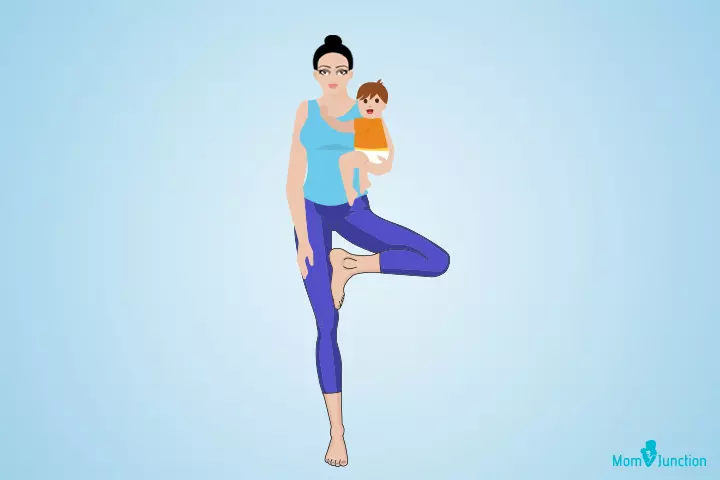
- Stand and hold your baby. You and your baby should be looking in the same direction
- Balance yourself against a wall
- Shift your body weight to your left foot
- Bend your right knee and place your right foot on the inner area of your left thigh above the knee area
- Hold the position for 10 seconds
- Repeat the pose with the other leg and do it five times for each leg
Benefits:
- Improves balance and posture
- Works on your concentration
- Calms the mind and body
When to avoid:
- A migraine
- Insomnia
- Low or high blood pressure
11. Flying with baby
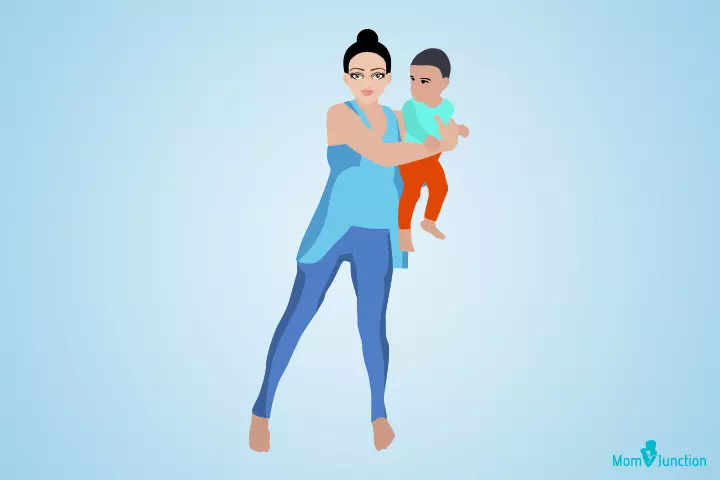
- Hold your baby facing outwards and stand hip-distance apart.
- Bend your knees while you exhale.
- Straighten your legs while you inhale.
- Shift your weight to your left foot while going on your toes on your right foot.
- Bend your knees and exhale and come to your original position.
- Inhale and shift your weight to your right foot, and come on to your left toes.
- Hold your baby around their mid-section and extend your arms out as you float from side to side.
Benefits:
- Builds leg, arms, and core strength
When to avoid:
- Pain in the legs, especially calf
12. Leg lifts
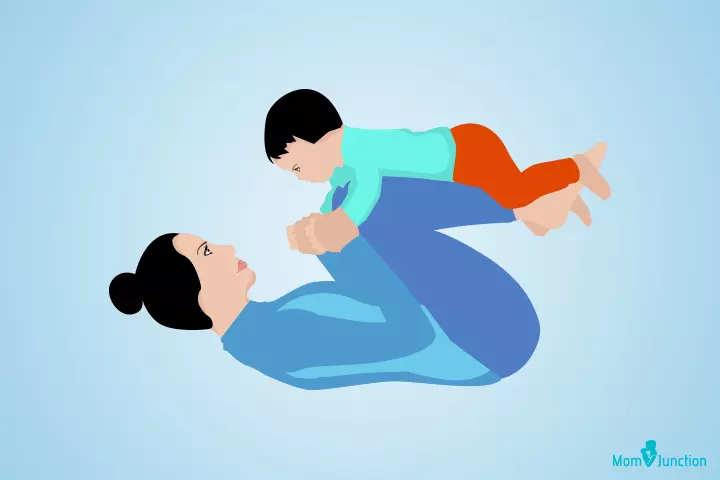
- Lie on your back
- Bend your knees and let your legs be parallel to the floor
- Place your baby on your legs and hold their hands
- Lift your shoulder off the floor and kiss your baby
- You can repeat the movement 5-10 times
Benefits:
- Strengthens your core muscles
When to avoid:
- Back and shoulder issues
13. Corpse pose (Savasana):
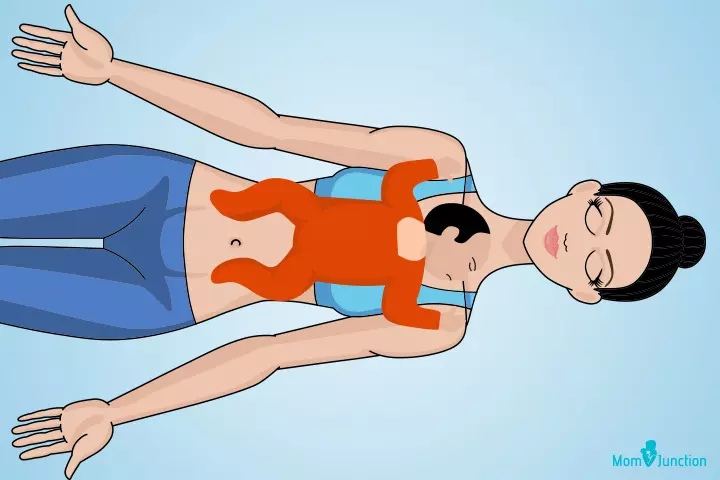
- Lie on your back with a distance of one foot between your legs
- Place your hands a little away from your thighs
- With hands open, face your palms upwards
- Close your eyes and keep your neck straight
- Focus, keep your mind calm and relax your body
- Take 5-6 deep breaths
- Let your baby rest on your chest
Benefits:
- Reduces fatigue after doing other yoga postures
- Reduces hypertension, heart diseases, and insomnia
- Increases concentration
When to avoid:
- You can do this relaxation asana without restrictions
With so many benefits for your body, you soon want to take up yoga, right? Let’s look at some more benefits for you.
Benefits Of Doing Yoga
Yoga is the best bet if you want to rejuvenate your body and mind after childbirth. Here’s why:
- Gives you an opportunity to bond with your baby: Every chance you get to spend with your baby is good enough for bonding and helps in fostering a strong parent-child connection. And during yoga you get to hold your baby, rock them, and interact with them.
 Did you know?
Did you know?- Makes you lose weight: Losing the baby weight and attaining your pre-pregnancy health and fitness can be challenging, but yoga helps you gradually lose your weight and tone your body. It is especially effective for the belly fat.
- Helps you heal quickly: Whether it is normal or Cesarean delivery, your body experiences pain and pressure. Yoga enables you to recover quickly from the pain. It relieves lower back pain and comforts your hip, back, and leg muscles.
- Reduces postpartum anxiety and depression: The hectic schedule with the baby, anxiety, and changes in the relationship with your spouse could result in physical and mental stress. Postpartum mothers can benefit from practicing yoga and meditation, as it can effectively alleviate symptoms of anxiety and depression while promoting a sense of calmness and mindfulness (3). Furthermore, yoga can serve as a source of peace and tranquility for new mothers who may be struggling to adjust to their hectic lifestyles.
- Improves your posture: During pregnancy, there is pressure on your lower back and spine muscles. Yoga includes stretching poses that help improve posture and relieves joint stiffness.
A mother shares her experience of doing yoga with her baby for the first time and what made it more enjoyable for her little one. She says, “Taylor and I attended our first Mommy and Me yoga class a few weeks ago and we loved it! It was so much fun to learn a new way I could play and bond with my babe! I learned from the class that using props and sounds was a great way to keep the babies engaged and entertained. During the class we sang baby songs and nursery rhymes while holding most poses and also incorporated scarves and a bell into some movements (Taylor particularly loved how the scarves blew in the wind!) (i).”
Frequently Asked Questions
1. Can I practice yoga with my baby even if I’m not very experienced?
You may practice simple poses with your baby if you are not very experienced. However, it is advisable to practice under the guidance of an expert to avoid any untoward events.
2. What should I wear when practicing yoga with my baby?
Choose clothes made from breathable fabric. Clothes that stretch help support the movements, and those with comfortable elastic waists conform to the body’s shape. You may also try tops with built-in bras.
3. Can I practice yoga with my baby if I had a C-section?
While practicing yoga after a cesarean section, it is advisable to consult your doctor and assess your recovery before practicing yoga after a C-section, especially with your baby.
4. Can I practice yoga with my baby if they are fussy or crying?
Yes. The different movements and poses may entertain the baby or make her feel attended. However, you should ensure that the baby is not fussy due to illness, hunger, or soiled diapers.
5. Can I practice yoga with my baby if they cannot sit up?
Babies who cannot sit up may have tummy time while you practice yoga poses. Poses such as the child pose, tiger pose, cobra pose, and corpse pose are suitable ones to try with a baby who cannot sit up.
While doing yoga after childbirth may aid in your recovery and help you stay fit, doing it with your baby will add to its benefits and allow you to spend more time with your little one. You can practice all the yoga poses for mom and baby listed above, including Balasana, Marjaryasana/ Bitilasana, Navasana, Trikonasana, and Malasana. However, take the necessary precautions and do not overexert yourself when practicing these yoga postures. Also, be mindful of your and your baby’s safety.
Infographic: Safe Yoga Positions For Mothers And Babies
Being healthy and physically active promotes faster recovery and good health in mothers after childbirth. However, many mothers fail to exercise regularly due to their busy routine and the responsibility of taking care of the baby. The following infographic includes some safe yoga poses you may try with your babies. These poses will allow mothers to bond with their babies while exercising.
Some thing wrong with infographic shortcode. please verify shortcode syntaxIllustration: Best Yoga Poses For Mom And Baby
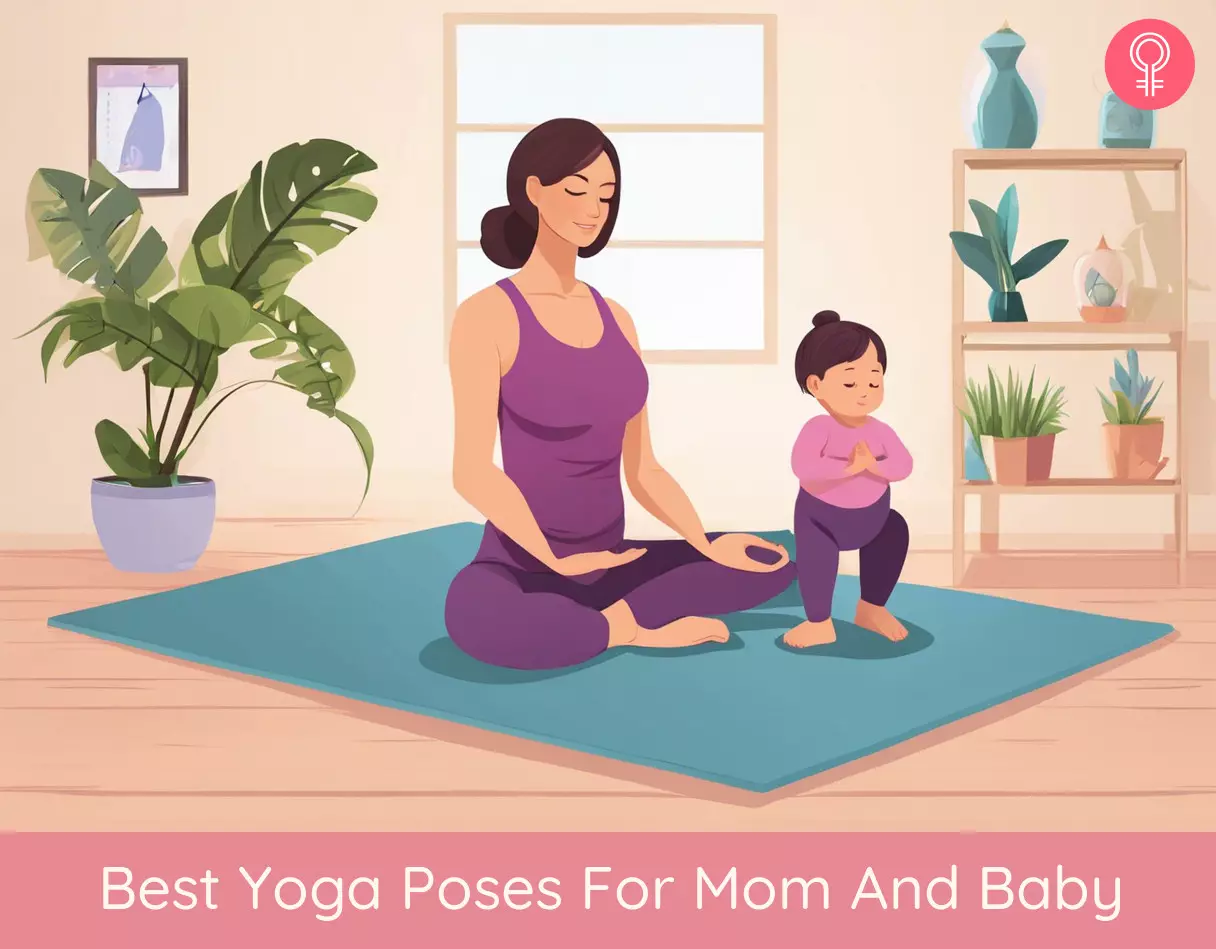
Image: Stable Diffusion/MomJunction Design Team
Personal Experience: Source
MomJunction articles include first-hand experiences to provide you with better insights through real-life narratives. Here are the sources of personal accounts referenced in this article.
i. Mommy and me baby yoga.https://gofastmommy.blogspot.com/2017/03/
References
- Postnatal Exercise.
https://www.betterhealth.vic.gov.au/health/healthyliving/postnatal-exercise#things-to-remember - MacDonald C; (2013); Mother and baby yoga is good for you.
https://europepmc.org/article/med/23789249 - Meditation outperforms meds on postpartum depression.
https://www.colorado.edu/asmagazine/2016/01/14/meditation-outperforms-meds-postpartum-depression
Community Experiences
Join the conversation and become a part of our nurturing community! Share your stories, experiences, and insights to connect with fellow parents.
Read full bio of Caroline Klebl
Read full bio of Kalpana M
Read full bio of Rebecca Malachi
Read full bio of Vidya Tadapatri















